David has some advice
for replica builders:
First off, so many of the questions that people have regarding how to get started can be answered by one or more Mustang restoration books available from speciality Mustang suppliers.
After all, underneath the modifications there is a Ford Mustang and many of the restoration tips apply across the board.
* see remark at the end
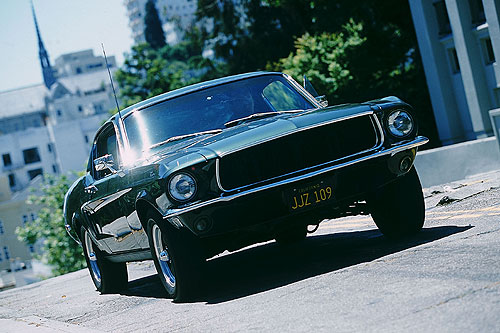
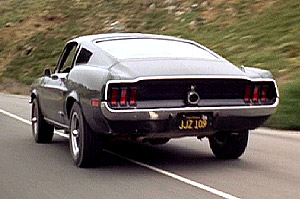
The original movie car on the Gouadeloupe Canyon Road
Secondly, purchasing a copy of the movie is essential. Do you really want to have to go out and rent it whenever a question comes up in your mind?
For a very small price (relative to what it will cost to put the car together) the updated DVD or VHS can be purchased at just about any good video retailer or on the internet. BlueRay is the new standard to spot even more details.
It's amazing how many times someone will ask endless questions about things that are fairly obvious, then admit that they haven't seen the movie in many years!
Get that home video/CD/DVD and utilize the beauty of freeze-framing. In addition to the actual chase, the new versions include a behind-the-scenes short that was shown in theatres to promote the film.
There are also taped interviews with the movie car "preparator" Max Balchowski available and the press shots.
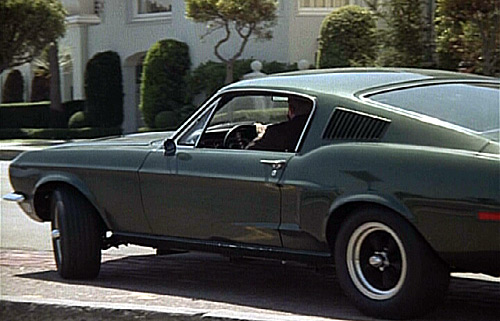
The original movie car before it heads into the chase scene

Oohps, better go with a Mustang, not Celica. Still, the owner of this car is a true BULLITT fan.
Once you have a good idea of what the car is supposed to look like, here's what you'll need:
Take the time to find a good car! You can spend a lot of time and effort trying to straighten and repair a bent or rusty car. Be patient and find the right starting vehicle -- it will make the project much more enjoyable.
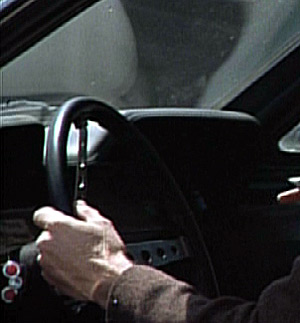
Of course, another color can be changed to black, but the cost and time in doing so adds to the challenge.
A fastback has many, many rare interior components. Painting or dying them black is another option, but doing it right is time consuming.
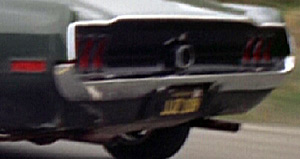
It will be up to each person how far they want to take this. In the movie, even the backup lights in the rear valance were removed (on that subject, both GT and non-GT valances are seen so you have a choice here). Again, look at the movie in slow motion and in still frame.
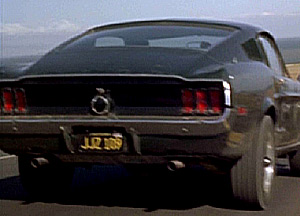
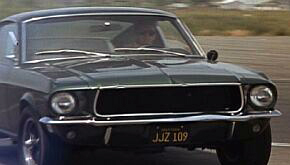
If you're just buying a reproduction grill, use a '67. They cost less than the '68s, due to fewer attachment points for the trim (which you won't be using).

In some scenes, the car has no mirror at all. For safety reasons, it may be more practical to stick with the stock rectangular mirror, and even add one to the passenger side. Mustang fastbacks have very bad blind spots to the rear, and for street use good mirrors are recommended.

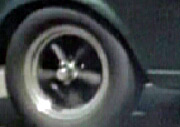
Front
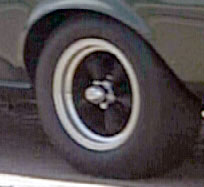
and rear
For some reason, the spokes on the new wheels come with more of a silver
gray spoke. With regard to rim width, the 6" wheels will give the right
look. You can use 7" versions, but the backspacing makes the center caps
"tuck in" too far past the rim edge. The center caps will come with American
Racing logo decals -- these should be peeled off.
Update
2015:
There
is a long-running question about which reproduction wheels are exactly like
the ones on the movie car. The answer seems to be: neither. Using some of
the more recently-discovered close-up still shots of the front wheel of the
car, and doing a bit of research on sites that detail the history of
aftermarket wheels, it seems that the American Racing wheels on McQueen’s
car were the Torq Thrust D. However, the versions made in the 1960s were
different than the modern reproductions.
Developed originally for the Corvette when it received disc brakes in 1965,
the design of the Torq Thrust D featured a hub that was placed farther out
from the centerline of the rim, and spokes that curved inward toward the rim
at their outer portion. That’s the key – the modern Torq Thrust D wheel has
spokes that are more of a constant radius. The irony is that, supposedly,
Mustangs with disc brakes didn’t need the D version of the wheel; only the
Corvettes did. But for whatever reason, a set of Torq Thrust D wheels were
fitted to the movie car. With that, it seems that not many of those wheels
were produced. Looking through sites that specialize in vintage wheels, it
seems that when you do run across the vintage D wheels, they’re with the GM
bolt pattern, and pretty much never the correct 5 x 4.5 for a Ford Mustang.
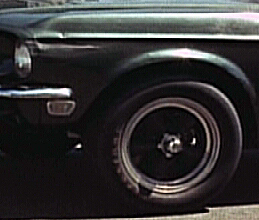
For a street-driven car, these may cause fender interference while turning. A good compromise is 215/65R-15, a size that is readily available in many different brands. Try to avoid the temptation to use a tire with a super-low profile (50 or 60 series). Short tires hadn't really been developed in 1968, and you don't want your Bullitt Mustang to look like it was attacked by the IROC Camaro club.
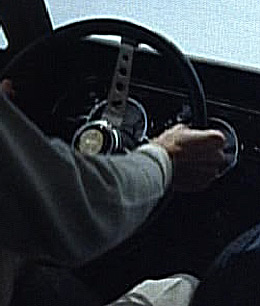
Hard to find information, but the wheels are often stamped with "F.I.V.", "SECURA" and "EFFPI" -- but nobody from any of the Shelby clubs have been able to tell me which one might be the actual company name. Similar wheels were also installed on Maseratis in the late 1960s, and also sold as accessory wheels throughout Europe. Shelby sold the wheels as accessories for the 1966 GT350, and also offered an over-the-counter version that anyone could put on a Shelby or Mustang, as it seems the folks involved in making Bullitt had done.
For the die-hard enthusiasts, a new EFFPI steering wheel is now available from David Mathews/SAAC or Tony Branda (www.cobranda.com) and some other Shelby parts suppliers.
The EFFPI wheel is manufactured in Switzerland and available with or without the leather wrapping for 2500/2800 dollar approximately.
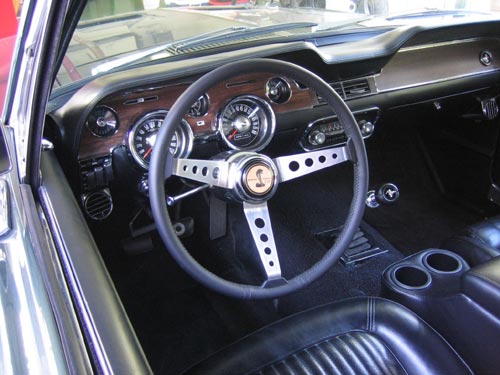
The new EFFPI replica wheel installed in Davids Bullitt replica and yes, he keeps the console.
With all that in mind, any
good three spoke steering wheel will look good. From a Grant wheel for about
$100, to the beautiful wheels from Moto Lita, Le Carra, and Nardi for
several hundred, there are any number of suitable wheels available. The
wheel should be 15" in diameter and slightly dished, with a black leather or
vinyl grip.
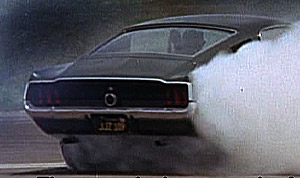
Look at a diagram of the original exhaust system in a restoration catalog and you can see what the system looks like. Your exhaust system will be a matter of personal choice; from the mellow sound of Walker Dynomax to the metallic crackle of Flowmasters, any modern system will do the job. Don't add any fancy tips if you want to look authentic; the movie Mustang used plain pipe.
Though Frank Bullitt shifted a 4-speed (with stock shifter), a 5-speed trans from a late-model Mustang would be a better choice if you're starting from scratch. An automatic will only be noticed by people who see the car parked and look inside; if you're zooming down the highway in your Bullitt, nobody will know the difference.
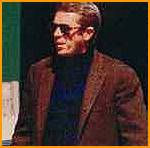
Too bad most car shows are in the heat of summer, or you'd want to wear this stuff when posing by the car. (Maybe a used mannequin would come in handy for the clothes as part of a complete display.) For the clothes, check vintage stores or places that sell upscale hunting garments.
For detailed answers you may also checkout this McQueen fansite
*You want the most accurate
replica?
..then don't forget to replicate the dings and dents!
Lastly, keep in mind that these are "guidelines," NOT RULES!!!
As far as we know, the Mustang Club of America is not about to add a "Concourse
Bullitt Mustang" category.
What modifications you choose are up to your personal taste and of course,
financial budget.
Let's
pick a statement from one replica owner
- "I'll never understand why
they - other owners (Ed) - don't put in the effort to detail their car
correctly"
Well, we admire
and certainly follow each trial to get the
car as close to the (which one of the two actually ?) original cars used in the
movie Bullitt, but since we've been adressed from various owners meanwhile that theirs
is the best and some Bullitt replicas are just lame out there, we would like to point
out that without the dents you'll probably never get close. How were they
done? Common believe is that McQueen wanted them in the car to have a look
like a poor cops car. Well another theory is that they might have occured
while McQueen and Hickman tried the cars out at the Cotati Raceway before
the movie. Look close at the related extra DVD scenes. Are you really willing to
replicate them? A still remaining topic for all Bullitt replica owners
striving for absoulte authenticy.
David
Kunz has been adressed with many statements that some replicas are better than
others or his over the past 17
years and here is again one advice for engaged Bullitt maniacs following our How-to
section on this webpage:
“The recommendations we gave are the basics and all that we know. Everyone
is welcome to create their own unique replica, based on their financial
means and time commitments. Watch the DVD or Blueray disc multiple times and
use your own descretion."
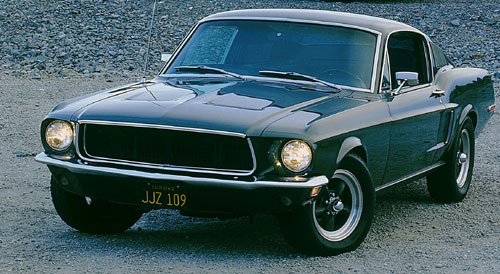
We have heard people say "I'm going to spend whatever it takes to build the most exact Bullitt Mustang anyone in the world has ever seen." If you have the monetary resources, great.
But to do that you're probably talking about a cash outlay in the neighborhood of $40,000 or more. That's up in Shelby territory, and you would have a hard time finding someone who is willing to pay that much for the car should you decide to sell. Have fun!
Editors comment: We will never promotea competition between individual owners, we like to accomodate every true Bullitt maniac and want to showcase your individual efforts, wherever they end up or whereever they stop.
Rest assured the original movie car will still be different from any replica whenever it appears. If nothing else, it would be the date stamps on any component, the tires or even the fluids so where do you stop with your efforts? And then a replica will be always a replica.
At this time any replica has more life in it than the original movie car and looks much better thrilling the spectators and audience.
We encourage you to realize your imagination and do additional research for the benefit of the Bullitt community here on this site. There won't be a Concours, Driven or whatever Judged class on Bullitt replicas, so just go ahead and do what you need to do. McQueen would not like to have an exact replica around most probably.
Regarding the details there are many rumours around - be it the truck springs that probably were used in the movie car or the mysterious shade of black out treatment, that we have not confirmed yet on the original surviving movie car. So just keep the fun in it, if you do a replica. It is worth to build the Bullitt replica your own way, because you need to enjoy it to relive the Coolness factor in driving it.
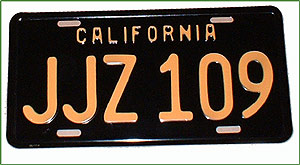
The
famous licence plate
The best reproductions available on the market are made out of stamped
aluminium. Carl Genatossio ran a second batch of these nice licence plate. They are sold for
20 US dollar each as of February 2008. Contact
him here to check for availability. The profit
goes to the IMBOC Bullitt Enthusiast website for keeping it alive.
Metal licence plates are typically not available legally due to U.S. laws
anymore.
However, legal or not there is a metal plate manufacturer online here.
We have no commercial interest in any these "deal" nor
are responsible for any claims you may have.